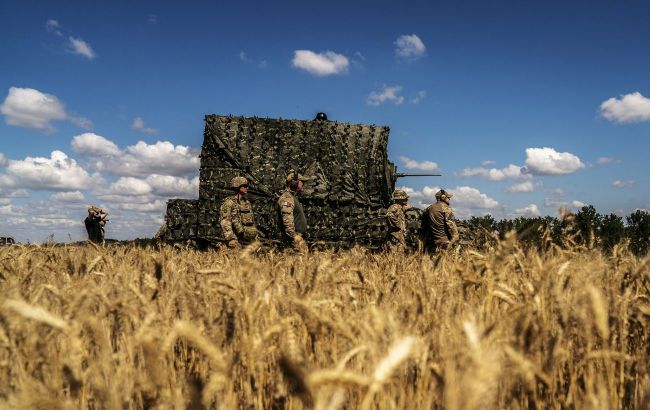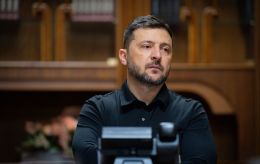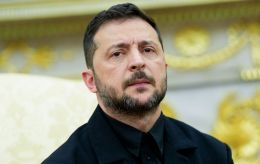Ukraine raises stakes. Events near Kursk and Russia's offensive
 Ukrainian troops take control of part of the Russian Kursk region (photo: Getty Images)
Ukrainian troops take control of part of the Russian Kursk region (photo: Getty Images)
During the week of fighting in Russia, the Ukrainian Armed Forces occupied more than a thousand square kilometers of the Kursk region. The article by RBC-Ukraine military and political observer Uliana Bezpalko describes the progress of the Defense Forces and what their plan might be.
Contents
A week ago, the Ukrainian military launched an offensive operation on the territory of the Russian Federation. This is not the first time our troops have entered the Russian border. However, unlike previous raids, this operation seems to have a different course, scale, and goals. This can be seen in the chaos unfolding in the communication between Russian officials and Z-bloggers. And it is confirmed by the seven-day public silence observed by Ukrainian government officials and the military.
In May of this year, Moscow decided to attack in the north of the Kharkiv region. In doing so, it wanted to create a so-called "buffer zone" to protect Russia's border regions from Ukrainian counterattacks. This idea obviously backfired on the Kremlin. While the enemy was occupied with Kharkiv and Donetsk regions, the Ukrainian command was probing for weaknesses directly on the Russian border.
In three months the enemy was able to advance up to 10 kilometers deep into Kharkiv region from the Belgorod region. The Ukrainian military covered the same distance on the first day of the offensive towards Kursk.
Events in Kursk region: Chronology
On the night of August 5-6, a group of Ukrainian troops managed to advance into Russian territory between Oleshnya and Nikolayevo-Darino in the Kursk region. Within the first day, the areas where our troops were embedded began to grow both in width and depth. One grouping of Ukrainian troops moved northwest toward the Korenevo-Rylsk direction, capturing the surrounding settlements along the way.
The second group moved northeast to the town of Sudzha. There it split into two more conditional groups. One of them went to cover Sudzha from the north to cut it off from the P200 highway to Kursk. The other continued the offensive to the north, toward Kromski Byky and Lgov. Our troops were moving along the banks of local rivers, which provided additional cover from flanking attacks.
On the second day, the fighting covered almost 350 square kilometers of the Kursk region in two districts - Sudzha and Korenevo. On the third day, the Ukrainian Armed Forces began to move in another direction - south of Sudzha - a conditional bridgehead from the Oleshnya River to the Psel River. After three days, the area of settlements where Ukrainian troops were spotted grew to 430 square kilometers, on the fourth day it was almost 600, and on the fifth day, it was 700.
As of Monday, August 12, according to the head of the military, Oleksandr Syrskyi, the Ukrainian Armed Forces controlled about 1,000 square kilometers in the Kursk region. To compare the scale, this is about the same area as the Sudzha district. DeepState analysts estimate that Ukrainian troops have occupied approximately 44 settlements, and the status of another 10 is unknown. The depth of the breakthrough reached about 35 kilometers.
A few hundred meters from the Sudzha checkpoint, which was captured in the first 48 hours, a gas metering station of the same name was taken over by Ukraine. It is part of the Russian gas pipeline that transits gas through Ukraine to Europe. The Sudzha gas metering station accounts for about half of Russia's exports to the EU.
Russia recognizes its losses only partially. Yesterday, at a meeting with Putin, the acting governor of the Kursk region said that the Ukrainian armed forces had captured 28 settlements and 480 square kilometers of territory.
While Ukrainian authorities have been silent on any movements by the Defense Forces for the past few days, Russian officials and so-called "military correspondents" have been spreading a lot of fake news on their own. Some reported that there were no battles, while others, on the contrary, talked about battles where there were none. Some of them began to call the operation itself the "Kursk Arc".
In general, we can say that in one direction, the Defense Forces have reached the Snahist line and have established control over part of the Sudzha-Rylsk rocade road. In the second direction, toward Lgov, Ukrainian units have reached Kauchuk and Anastasievka. On the third section along the P200 road, the Defense Forces seem to have managed to establish full control over the town of Sudzha and reached the Russkoe Porechnoye-Martynovka line. In the fourth direction, near the Psel River, they have reached Plekhovo and Borki.
Moreover, over the past two days, the combat zone has spread to several neighboring districts. Local officials and Russian bloggers have reported seeing Ukrainian troops in the Belovsk district of Kursk region near Giryi and Belitsa. Yesterday, they called on residents to evacuate. At the same time, the Russian authorities announced an evacuation in the district located in the Belgorod region - in Krasnoyaruzsk. The Ukrainian Armed Forces were spotted there near the Kolotylivka checkpoint.
In recent days, the advance of the Ukrainian military has begun to slow down somewhat, but not so much because of Russian reinforcements, but rather because of the increase in the number of settlements on the routes and the distance from the rear.
How Russia missed the offensive and what are Ukraine's goals
The Kursk region is part of the area of responsibility of the Russian military unit "Sever" ("North"). In May, the number of this group was estimated at 50,000, but most of it is involved in the fighting in the Kharkiv region from the Belgorod region. Instead, the task of covering the border in the neighboring Bryansk and Kursk regions turned out to be actually assigned to light infantry, a kind of local self-defense and border guards. The strongholds were few and scattered over long distances. Moscow began to transfer regular forces to the Kursk region only after three days of the Ukrainian offensive.
Ukrainian generals were obviously aware of all these problems and successfully used them to achieve operational surprise, as was the case in the Kharkiv region in 2022. Back in May, the Ukrainian information space started talking about the enemy allegedly planning to attack Sumy from Sudzha, and thus our command had a publicly justified reason to pull troops in this direction.
The nature of this operation, its depth, and the participation of regular troops and engineer units already indicate that this is not a short-term raid. Given the route of the Ukrainian Armed Forces, the immediate tasks of Ukrainian units in the Kursk region are to take control of the P200 and E-38 roads, which could significantly disrupt the logistics of the Russian military group Sever. However, all of this, one way or another, is part of a larger plan and goals.
The first of these may be an attempt to relieve Russian pressure in the north of the Kharkiv region, in the area of Lyptsi and Vovchansk. Moscow has already begun to close the gaps in the Kursk region with reserves and additional forces from the Sever military unit, including units from the Kharkiv direction. If the crisis there intensifies, the Defense Forces can use this situation to push the occupiers from Vovchansk back to Russia.
In addition, the enemy is already moving some troops there from other directions - from Kupiansk, Kherson, and Zaporizhzhia. Some Russian "military correspondents" are already putting forward theories that the Kursk operation is just a distraction to strike at a completely different operational direction.
There is no information yet on whether the Kremlin has begun to move reserves and units from the Donetsk region to Kursk. It is there that the key areas of the Russian offensive and the largest groups of occupation forces are located.
This includes the Pokrovsk direction, where the enemy is trying to reach the T0504 Pokrovsk-Kostiantynivka road with a wide front. It plays an important role in supplying our units defending the Donetsk region.
It is the Toretsk district, where since mid-June the Russian troops have captured five settlements, almost occupied the whole of Niu York, and reached the outskirts of Toretsk. If this city falls, the aforementioned T0504 road and Kostiantynivka are at risk. And then there is Chasiv Yar, where the enemy was able to capture the eastern part of the city, but failed to advance to the western bank of the Siverskyi Donets-Donbas channel in a few months.
This includes the area of Kurakhove, where the enemy continues to try to form a northern flank to cover Vuhledar and has already managed to cut one of its main supply roads near the village of Kostyantynivka.
The Russian crisis near Kursk has not yet affected the dynamics of the fighting in the Donetsk region. However, if it continues to deepen, it is likely that the enemy will face a choice: advance in Donbas or hold on to Kursk. Perhaps our command was betting on the latter.
The third version is that Ukraine wants to make Putin negotiate from a stronger position, where the subject of territory exchange will be discussed, rather than compromises. Some pro-Putin "experts" fear that the war zone could expand into the neighboring Bryansk and Belgorod regions. Under this logic, Ukraine's stakes in the negotiations could indeed become high, as well as the potential risks, given the scale of the forces that would need to be involved in such an operation.

